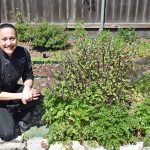It’s common knowledge that nutrition is an important part of well-being. We’ve dedicated a lot of resources to this very topic and designed programs to provide nutritional guidance. Our dining halls are proof that young people can, and do, enjoy nutrient-dense meals at school. But, if you struggle with helping your child choose nutritious foods at home, here are some ways you can implement our strategies to develop a balanced nutritional practice with your family.
Basic nutritional messaging helps promote lifelong nutritious eating habits. In the communities we serve, we use The SAGE Spotlight Program®, a tricolor labeling system based on nutrient density and the latest USDA guidelines. Students’ food choices are guided by colored dots on each menu item that show them how to create plates that are varied and balanced.
How do you replicate this at home? With younger children, try sectioned plates. Encourage them to put the most nutrient-dense foods in the largest section, and the least nutrient-dense foods in the smallest section. The SAGE philosophy is that all foods fit, and everything has a place when you practice the principles of variety, balance, and moderation.
For picky eaters who challenge every attempt at trying new and different foods, take it slowly but steadily. Offer just one new food at a time and introduce new foods alongside familiar favorites. Once one new food is accepted, then introduce others that have similar colors, flavors, and textures.
For older children, use the Spotlight program as a way to start a conversation about nutrition. Talk about how they built their plate in school with a variety of different foods, and how they can do the same at home. Ask them how they feel on days when their choices are not as balanced, and how they feel if they’re eating the same things over and over. By continuing to promote variety, balance, and moderation, you’re helping reinforce the philosophy behind Spotlight.
In an increasingly fast-paced world, it’s easy to become disconnected from food sources. Knowing where our food comes from encourages consumption of fruits and vegetables. In our dining halls, we inform our guests about food sources with fun facts in the servery. We teach them about ingredients and the local farms that grew them. You can do the same at home. Break down your meals into parts and talk about where and how each item was grown. If an ingredient is out of season or not grown locally, talk about how it got to your plate. Visit farmers markets and local produce stands and talk with the farmers; all of this helps build a greater understanding about food and nutrition.
Approximately 75% of the schools we serve enjoy community-inclusive dining. In a community-inclusive setting, all students, including those with food allergies, choose from a variety of nutrient-dense selections and eat their meals together, each day. There are many benefits to this approach, including fostering camaraderie and inclusion. Similarly, your family can designate family mealtimes. Eating together is one of the simplest and most effective ways to promote healthy eating habits.
Research shows that a supportive environment is key to changing individual, nutrition-related behaviors. At SAGE, we’ve got the school environments covered ꟷ and by continuing the conversation, your family can enjoy nutrient-dense options at home, too.








